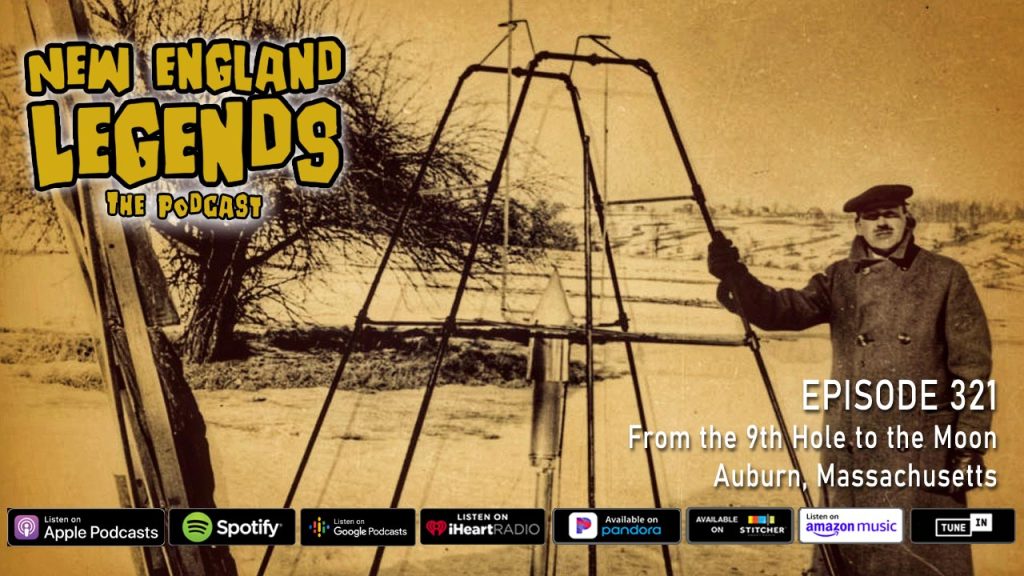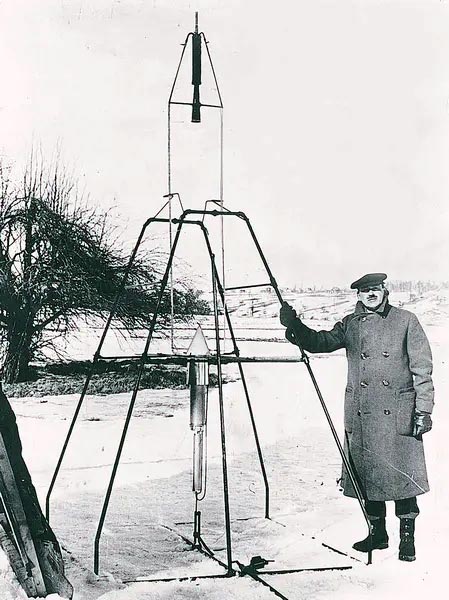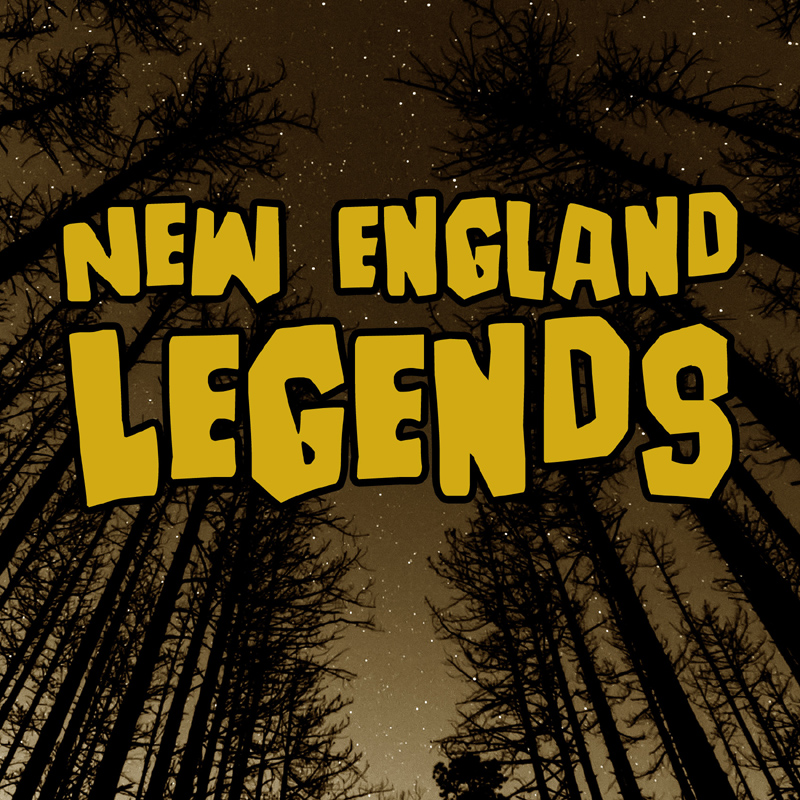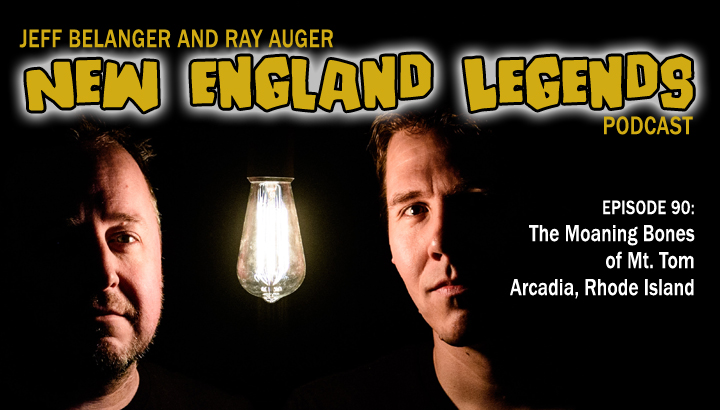
In Episode 321 Jeff Belanger and Ray Auger take a swing at Pakachoag Golf Course in Auburn, Massachusetts, where near the 9th hole back on March 16, 1926, Robert Goddard launched the world’s first liquid-fueled rocket. If not for what happened here we may never have gone to space, reached the moon, and beyond. Sometimes it takes a dreamer to leap us forward.
BECOME A LEGENDARY PATRON:
https://www.patreon.com/NewEnglandLegends
CREDITS:
Produced and hosted by: Jeff Belanger and Ray Auger
Edited by: Ray Auger
Theme Music by: John Judd
SUBSCRIBE TO THE PODCAST FOR FREE:
Apple Podcasts/iTunes | Google Podcasts | Spotify | Pandora | Amazon Podcasts | TuneIn | iHeartRadio
JOIN OUR SUPER-SECRET:
New England Legends Facebook Group

Robert Goddard with the world’s first liquid-fueled rocket in Auburn, Massachusetts, in the year 1926.

The monument marking the launch site of the world’s first liquid-fueled rocket at Pakachoag Golf Course in Auburn, Massachusetts. Photo by Daniel LaShomb.

Photo by Daniel LaShomb.
EPISODE TRANSCRIPT:
*A note on the text: Please forgive punctuation, spelling, and grammar mistakes. Like us, the transcripts ain’t perfect.
[GOLF CLUB SWING / HITTING GOLFBALL]
JEFF: FORE!
[IN THE DISTANCE – OWWW!]
RAY: Jeff, it’s fair to say that you stink at golf.
JEFF: what are you talking about!? I’m totally winning. I have like 84 points and we’re only on the 9th hole here at Pakachoag Golf Course!
RAY: Right… but the objective of golf is to score LESS points. Strokes are bad.
JEFF: Ohhhhh. Well, you’re up.
[GOLF CLUB SWING / HITTING GOLFBALL]
JEFF: Wow! I can’t even see where it went that went up so high.
RAY: Probably to moon.
[THUMP]
JEFF: It had all the height but not much distance.
RAY: It’s safe to say we both stink at golf.
JEFF: We do. It’s funny you mention your ball going to the moon because if it wasn’t for something that happened up here on the 9th fairway, we may have never gone to space or walked on the moon at all.
RAY: Really?!
JEFF: Yup. We’ve come to the 9th hole at Pakachoag Golf Course in Auburn, Massachusetts, to witness the launch of the world’s first liquid-fueled rocket.
[INTRO]
JEFF: Hello, I’m Jeff Belanger.
RAY: And I’m Ray Auger, and welcome to Episode 321 of the New England Legends podcast. Thanks for joining us on our mission to chronicle every legend in New England one story at a time. From roadside oddities, to ghosts, monsters, UFOs, strange creatures, true crime, and odd history, we love all the weirdness that makes New England great.
JEFF: And did you know that most of our story leads come from you! This one did. Thanks to Daniel LaShomb for tipping us off. If you’ve got a story you think we should check out, please reach out to us anytime through our Web site.
RAY: We’ll go searching for the world’s first liquid-fueled rocket, right after this word from our sponsor.
SPONSOR
JEFF: Ray, I’m a space flight nerd.
RAY: I get it. What’s cooler than launching a rocket into space?
JEFF: Ever since I was a kid I loved watching space launches on TV, reading about astronauts, and pondering all things space. I once wrote a children’s book called What It’s Like to Climb Mount Everest, Blast Off Into Space, Survive a Tornado, and Other Extraordinary Stories. For the book I got the chance to interview astronaut Sandy Magnus who flew on multiple space shuttle missions and she spent time aboard the International Space Station.
RAY: That’s really cool!
JEFF: She was an amazing storyteller. Describing the feeling of leaving the launchpad as if you’re sitting in a rolling office chair and someone runs up and kicks you from behind. It looks smooth and easy from the outside, but it doesn’t feel that way on the inside. Buuut she might not have gone anywhere if not for what happened here on the 9th fairway at Pakachoag Golf Course.
RAY: And I thought golf was boring.
JEFF: (LAUGHING) It is! But what happened here before there was a golf course, was far from boring. What happened here at the current 9th fairway, changed the world. So let’s head back to 1926, and witness history here in Auburn.
[TRANSITION]
RAY: It’s March of 1926 here in Auburn, Massachusetts, and a 42-year-old local man named Robert H. Goddard is hard at work.
[METAL HAMMERING]
JEFF: Goddard was born in nearby Worcester, Massachusetts, in 1883. From a young age he fell in love with math and science, but he had a healthy dose of sci-fi thanks to reading novelists like H.G. Wells, especially his 1898 book, War of the Worlds. Goddard attended Worcester Polytechnic Institute for his undergrad, and got his doctorate in physics from Clark University—also in Worcester. All the while dreaming of reaching the upper atmosphere of earth and then space beyond that.
RAY: By 1914, Goddard had already filed his first two patents for multi-stage rocket fueled by liquid.
JEFF: We should point out that solid fueled rockets have been around for centuries. The Chinese first experimented with them in warfare as explosives, and of course fireworks use a gunpowder mixture to propel the rockets skyward. But gunpowder rockets are inaccurate and can be unpredictable.
RAY: Right, but liquid fuel is different. Goddard needs something that will sustain a controlled thrust, not burn up quick like a bottle rocket. On paper, Goddard believes he can build a vehicle to reach higher than humans had ever gone before.
JEFF: Like anyone far ahead of his time, Goddard didn’t get much support.
RAY: I get it, though. The Wright Brothers made their first flight at Kitty Hawk only 23 years ago. We’re barely crawling in terms of powered human flight. And Goddard is talking about rockets and outer space?!
JEFF: Still, things are changing fast. The world just went through a horrible world war a decade ago, and since then many innovations have been popping up. To Goddard, rocket flight is the next logical step after propeller planes. Even though he has no backing from anyone, he uses his own time and resources to work on designs for his rocket.
RAY: Goddard did eventually get some help in the form of a $5,000, five-year grant from the Smithsonian Institute back in 1917. The Smithsonian also published Goddard’s manuscript titled: A Method of Reaching Extreme Altitudes.
JEFF: But Goddard still has his detractors. In 1920, a New York Times editorial scoffed at Goddard’s ideas and designs. The editorial reasoned that rockets can’t work in the vacuum of space because they need to push against air in order to propel forward. They reasoned that Goddard is wasting his time.
RAY: But that all becomes fuel for the rocket fire. Goddard is motivated. He’s been experimenting with gasoline as the fuel and liquid oxygen as the oxidizer.
JEFF: After years of tinkering and drafting designs, Goddard feels ready to unveil his prototype—a rocket he calls Nell.
[DRILLING / TOOLS SOUNDS]
RAY: Okay, Goddard’s rocket is a strange looking contraption. It stands about 12 feet tall, but most of it is empty space taken up by a metal framework. There’s a small cylinder at the very top with what looks like a small cone under it, like a rocket engine—it’s maybe the size of a canister of tennis balls. About five feet below that is another small rocket-looking thing with a cone, and below that is a single post almost like the end of a walking cane. If Goddard doesn’t hold this rocket upright, it will fall right over. It can’t stand on its own.
[SLOW BUILD OF LIGHT WIINTER WIND]
[WALKING THROUGH CRUNCHY SNOW]
JEFF: It’s Tuesday, March 16, 1926. Robert Goddard has brough his rocket out to his Aunt Effie’s farm here in Auburn. With Goddard is his wife, Esther, and a couple of assistants from Clark University where Goddard is a professor.
RAY: It’s cold here today. The ground is covered with a thin layer of snow. This winter isn’t ready to let us go just yet.
[METAL HAMMERING]
RAY: Goddard is assembling a square metal frame that looks almost like a small swing set. This frame will hold the rocket upright until launch.
JEFF: This is exciting. Goddard is attaching a hose from the bottom of his rocket to a tank of liquid oxygen.
RAY: We should back up.
[WALKING IN SNOW]
JEFF/RAY: 10, 9, 8, 7, 6, 5, 4, 3, 2, 1….
[ROCKET SOUND]
RAY: Okay, uhhhmmm it didn’t go all that high. And it crashed into the ground less than a football field away from the launchpad.
JEFF: Officially, the rocket affectionately called Nell hit a height of 41 feet and flew a distance of 184 feet before crashing into the ground.
RAY: I’m pretty sure I can hit a golf ball higher than 41 feet, and further than 184 feet. And as we already know, I stink at golf.
JEFF: That height and distance is definitely doable for a could of hacks like us.
RAY: So I guess Goddard has a long way to go.
JEFF: He does. But the Wright Brother’s first flight was only 852 feet in distance. You gotta crawl before we can walk… Goddard just made the first movement with liquid-fueled rockets. and that brings us back to today.
[TRANSITION]
JEFF: Robert Goddard died in 1945 in Baltimore, Maryland. He was 62 years old. He didn’t live long enough to see humans fly into space on a rocket, but those who came after him stood on the shoulders of a giant.
RAY: In 1939, the family that owned the Auburn farm converted it into the Pakachoag Golf Corporation, and it’s been a golf course ever since.
JEFF: A golf course with a unique man-made obstacle here on the 9th fairway. Let’s check it out.
RAY: There’s a little sectioned-off garden maybe five-feet by five-feet, and in the middle is a small stone obelisk, about three feet high.
JEFF: Go ahead and read the inscription on the obelisk.
RAY: It says: Site of launching of world’s first liquid propellant rocket by Dr. Robert H. Goddard, 16 March 1926.
JEFF: At the very least, this is a hazard for flying golf balls.
RAY: Not the way we hit them.
JEFF: True enough. Robert Goddard was the best kind of dreamer. Raised on science fiction, those early impressions had him reaching for the stars. To him it wasn’t fiction he was reading, it was a build spec. He just had to figure out how to make it a reality. Though the first flight only reached 41 feet, a seed was planted that grew into rockets, a space shuttle, and commercial space travel today. Oh, and remember that editorial published by the New York Times in 1920 that scoffed at Goddard’s ideas?
RAY: Yeah.
JEFF: On July 17, 1969, the day after Apollo 11 lifted off on its trip to land the first humans on the moon, the New York Times printed a correction 49 years after the fact. Go ahead and give this a read.
RAY: Okay, it says: Further investigation and experimentation have confirmed the findings of Isaac Newton in the 17th Century, and it is now definitely established that a rocket can function in a vacuum as well as in an atmosphere. The Times regrets the error. Better late than never, I guess.
JEFF: Today the Goddard Space Flight Center in Maryland is named after him. And he also has moon crater named in his honor. As we stand here on the 9th fairway dodging golf balls on this Auburn golf course, it’s pretty wild to think what started here has taken us to the moon and beyond. It’s only fitting we give the last word to Robert Goddard who said, quote, “It is difficult to say what is impossible, for the dream of yesterday is the hope of today and the reality of tomorrow.”
[OUTTRO]
RAY: So true. It takes a dreamer to leap us forward. And that takes us to After the Legend where we explore this week’s story a little deeper and sometimes veer off course.
JEFF: After the Legends is brought to you by our Patreon Patrons who have been supporting a couple of dreamers for years. Bringing you two podcasts each week takes a ton of time, money, and effort. We love doing it, but the hosting costs, production, marketing, and everything else can really add up. So we appreciate our patreon patrons kicking in just $3 bucks per month – though some choose to give more. And for that they get early ad-free access to new episodes, plus bonus episodes and content that no one else gets to hear. To become an even bigger part of this community please head over to patreon.com/newenglandlegends to sign up.
Please do us a favor and click subscribe on the New England Legends podcast wherever you get your podcasts, and then post a review for us. It takes only a second and help a lot so others can find us in a crowded sea of podcasts. Be sure to check out our Web site for dates to Jeff’s Fall story tour and to see my band the Pub Kings, plus there’s links to buy Jeff’s new book and calendar. We love when you visit us.
Thank you to our sponsors, thank you to our patreon patrons, and our theme music is by John Judd.
Until next time remember… the bizarre is closer than you think.



